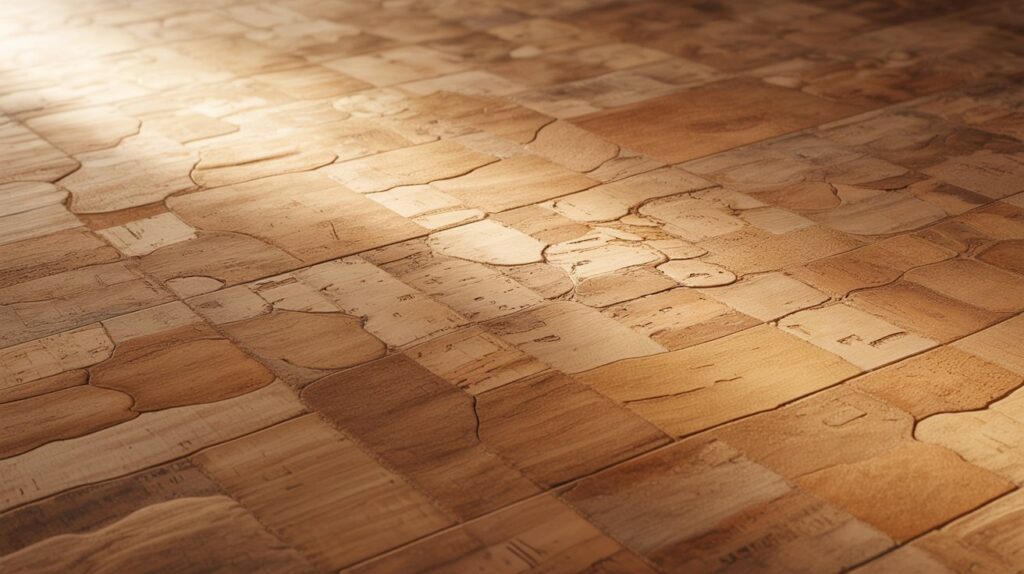I have been, or can be if you click on a link and make a purchase, compensated via a cash payment, gift, or something else of value for writing this post. As an Amazon Associate, I earn from qualifying purchases. Please read my full Affiliate Disclosure for more information.
Cork flooring gives you a warm, soft underfoot feel thanks to its cellular structure and natural elasticity, which cushions every step. You’ll notice improved acoustics and year‑round insulation as hollow cells trap air and dampen sound. Sustainably harvested from bark, cork renews every 9–12 years without felling, supporting biodiversity and lower embodied energy. Durable finishes protect wear and moisture, while low emissions and closed cells help IAQ. Continue to uncover how these elements come together for your space.
Key Takeaways
- Cork flooring provides a soft, cushioned underfoot feel due to its elastic cellular structure and air-trapped hollow cells.
- Its sound-damping and insulating properties reduce impact noise and maintain comfortable indoor temperatures.
- Sustainable cork is renewably harvested from bark without cutting trees, with harvest cycles every 9–12 years.
- Durable finishes and proper maintenance protect wear, UV stability, and moisture resistance for long-lasting comfort.
- Low-emission materials and closed-cell composition support healthy indoor air quality and mold resistance.
Why Cork Flooring Feels Warm and Soft Underfoot
Cork flooring feels warm and soft underfoot thanks to its cellular structure and natural properties. You’ll notice a gentle, cushioned feel that remains stable under daily use, thanks to cork elasticity that returns to shape after pressure. The material’s hollow cells trap air, delivering steady, low-density cushioning across room areas. This structure also enhances thermal insulation, reducing heat transfer and helping maintain comfortable temps without added effort. You’ll experience consistent comfort from room to room, even with varying subfloors. Combined with its lightweight composition, cork yields a forgiving, comfortable walking surface that supports long-term wear.

The Acoustic and Insulation Benefits of Cork
The acoustic performance of cork flooring hinges on its cellular structure, which absorbs and diffuses sound to reduce impact noise and footfall transmission. You’ll feel steadier acoustics as air gaps trap sound waves, and the surface dampens high-frequency jitter. This also helps with thermal comfort, since fewer drafts travel through the floor. Soundproofing benefits arise from the balance of mass and elasticity, while the dense cells provide consistent insulation across rooms. Thermal insulation properties minimize heat flux, aiding year-round comfort without heavy insulation.
- Cell structure dampens footfall crackle and airborne noise
- Elastic matrix reduces impact transmission
- Consistent indoor temperature with less heat loss
- Quiet, comfortable rooms for living and working
Sustainability and Renewal: How Cork Is Harvested and Regrows
Sustainability in cork comes from the bark-harvest cycle: cork oak trees are harvested without felling, allowing the tree to live and regrow its bark. In this system, you benefit from a renewable resource with minimal ecosystem disruption. Cork forest management prioritizes protected stands, soil health, and biodiversity alongside yield. Harvesting techniques emphasize precise decortication methods, timing to maximize bark quality, and rapid re-growth cycles. You’ll notice recurring harvests every 9–12 years, maintaining productivity while preserving carbon storage. This approach delivers consistent material supply, reduced embodied energy, and long-term environmental stability for architects and designers seeking sustainable performance.
Choosing Finishes, Durability, and Maintenance for Cork Floors
Choosing finishes for cork floors hinges on balancing protection with a natural feel: sealers and topcoats should enhance durability without masking the material’s acoustic and thermal benefits. You’ll consider design options and how they affect feel, slip resistance, and maintenance intervals, then pair choices with installation techniques that preserve soundproofing and resilience.
- Design options: matte vs. satin finishes, tinted sealers, and eco-friendly formulations
- Durability goals: wear layer protection, UV stability, and moisture resistance
- Maintenance rhythm: regular dusting, occasional re-sealing, and spill protocols
- Installation techniques: proper acclimation, subfloor prep, and careful UV-curing schedules
Health and Indoor Air Quality Advantages of Cork Flooring
Cork flooring contributes to healthy interiors by minimizing volatile organic compounds and supporting good indoor air quality, thanks to its natural composition and low-emission manufacturing. You’ll experience reduced toxin load without sacrificing performance. Its closed-cell structure resists moisture, aiding mold resistance in typical humidity zones and helping maintain stable air quality. The material’s elasticity dampens airborne dust dispersion, supporting allergy relief by limiting irritants. Quick-release bonding and low VOC finishes further minimize emissions after installation. For ongoing performance, choose certified seals and proper ventilation. Overall, cork pairs comfort with measurable IAQ improvements, aligning design intent with health-focused sustainability.
Conclusion
You’ll feel the warmth and softness underfoot, without sacrificing tech-minded performance. Cork’s natural structure dampens sound and insulates, so rooms stay calmer and cozier. Its renewability supports a sustainable design narrative you can trust, with harvests that regrow and minimize waste. With smart finishes and durable, easy maintenance, cork keeps its look longer. Prioritize low-VOC options to protect indoor air quality. In short, choose cork for comfortable, responsible, design-forward spaces.

Leave a Reply